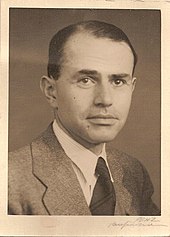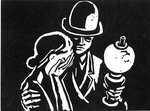Kurt Scheele
Kurt Scheele (born May 19, 1905 in Frankfurt am Main ; † November 9, 1944 near Smolensk ) was a German painter and wood cutter . His undestroyed oeuvre includes approx. 330 woodcuts , 150 oil paintings , watercolors , gouaches , copper engravings , brush and pen drawings, as well as some literary works. Kurt Scheele gained international recognition in the 1930s. For example, in 1936 Dwight D. Eisenhower acquired an oil painting by Kurt Scheele at an exhibition in New York . From 1937 Kurt Scheele's pictures were considered “ degenerate ” in National Socialist Germany , so that Kurt Scheele was forgotten after the Second World War .
life and work
Scheele began his training as an artist in 1922 at the Frankfurt School of Applied Arts (Fachschule für Buchgewerbeschule) under the type artist and painter Albert Windisch . At the same time he studied at the Offenbach School of Applied Arts with the commercial draftsman and type artist Rudolf Koch . In 1924 he switched to Franz Karl Delavilla , a representative of Expressionism, at the Städelschule in Frankfurt . Here he mainly studied drawing and painting.
Berlin impulses
In 1927 Scheele moved to Berlin and belonged to the artist group “ Juryfrei ” in Berlin and from 1937 to the “ Darmstadt Secession ”. His friends included u. a. Emil Nolde , Ernst Barlach and many other important artists of his time. In the years up to 1930 he went on study trips to Denmark , France , Italy , Norway and Switzerland . From 1929 he attended the painting courses in the art school in Berlin, newly founded by Martin Bloch and Anton Kerschbaumer , and turned to woodcuts , which became his real profession. Many watercolors were also created.
recognition
In 1929 a large number of exhibitions began with his works. Sometimes he was able to exhibit several times a year alone or take part in collective exhibitions, for example in 1929 in Berlin, 1931 in Ohio / USA , in Potsdam , 1932 in Berlin and Essen , 1933 in Essen, Duisburg , Cologne , 1934 in Mannheim , 1935 in Leipzig , 1936 in New York, Frankfurt a. M. and Braunschweig and 1938 in Darmstadt . Museums in Aachen , Düren , Essen, Hanover , Cologne, Krefeld , Wuppertal , Chicago and Oslo bought his works. Scheele was considered a highly talented artist at this time.
Ostracism as degenerate art
By gradually breaking away from Late Impressionism and Expressionism and switching to artistic representation without reference to a figurative reality, he aroused the displeasure of the Nazi regime , which classified the corresponding abstract works of his as " degenerate " and by 1937 six corresponding works seized by Scheele. In 1939 the National Socialists tightened the measures against Scheele and issued a general exhibition ban.
Conscription, captivity, and death
In 1940 he was offered a professorship in Cairo, which he was unable to take up because the war broke out. Instead, he was called up for military service that same year at the age of 35. Against the background of the ostracism by the National Socialists, this appears to be another politically motivated harassment against the artist. In 1943 bombs destroyed his Berlin studio and most of his works. Used on the Eastern Front, he was taken prisoner by the Soviets and died in November 1944 in or near Smolensk . He was probably infected with typhus or typhoid .
Rediscovery
In September 1965 a memorial exhibition was opened in Miltenberg on the occasion of his 60th birthday. It showed a comprehensive overview of his work (oil paintings and woodcuts). In November of the following year, works by Kurt Scheele together with the first works of his son Claus Scheele (* 1943), who is still active as a sculptor, were shown in a group exhibition in the Atelier Domo in Wertheim am Main . Then it took almost thirty years until the forgotten artist was given another exhibition. The retrospective took place on November 1st, 1992 in the Bodo Niemann gallery in Berlin. In 2005, his works were on view in the collective exhibition “Our way through the night” of the “ Community Foundation for Ostracized Arts ” in the Baden Museum in Solingen- Grafrath.
Work
Woodcuts
- Black-and-white
- Multicolored
- Spontaneous drawings
Exhibitions and participation in exhibitions (extract)
- 1929 Berlin, autumn exhibition of the academy "Black and White"
- 1929 Berlin, exhibition of the jury free
- 1931 USA, Cleveland Ohio, Paint Club Ohio
- 1931 traveling exhibition, Association for Art Education
- 1931 Cologne, Berlin, Königsberg, traveling exhibition "Stone, Wood and Copper Engraving"
- 1931 Potsdam, general independent exhibition
- 1932 Berlin, collective exhibition of the jury-free
- 1932 Essen, Folkwang Museum , complete exhibition
- 1933 Essen, abstract exhibition
- 1933 Duisburg, Museum Duisburg, illustration series for Gerhart Hauptmann's novel "Wanda"
- 1933 Cologne, Wallraf-Richartz-Museum
- 1934 Mannheim, art association
- 1935 Leipzig, Wuppertal, Bad Harzburg, Goslar, Krefeld, Deutsche Graphikschau
- 1936 Cologne, art association
- 1936 USA, New York, exhibition of the illustration series for "Peer Gynt"
- 1936 Munich, Art Association Munich
- 1936 Warsaw, International Woodcut Exhibition
- 1937 Frankfurt, Museum of Applied Arts
- 1937 Braunschweig, woodcut exhibition
- 1938 Darmstadt, Darmstadt Secession Exhibition
- 1938 USA, Chicago, Art Institute, III
In memoriam:
- 1946–1948 Nuremberg, Munich, Bremen, Minden, Miltenberg, Frankfurt am Main, partial exhibitions of Scheele's woodcuts
Publications
- The prisoner. Joseph von Eichendorff, Frankfurt a. M.,: Kurt Scheele, 1924.
- Borst Bernhard (Ed.): Architecture. 2nd year 1926, issue 10 title: Architecture and film with drafts by the artist.
- 50 woodcut illustrations for Wanda by Gerhart Hauptmann. around 1932, 51 illustrated sheets.
- Little Frankfurt stories. Peter Naacher Verlag, Frankfurt a. M., 1941, 94 pages with b / w drawings.
literature
- Woodcuts (exhibition catalog). Galerie Bodo Niemann, Berlin 1992, 47 pages, ISBN 3-926298-19-7 .
- Scheele, Kurt . In: Hans Vollmer (Hrsg.): General Lexicon of Fine Artists of the XX. Century. tape 4 : Q-U . EA Seemann, Leipzig 1958, p. 178 .
- Scheele, Kurt . In: Hans Vollmer (Hrsg.): General lexicon of fine artists from antiquity to the present . Founded by Ulrich Thieme and Felix Becker . tape 29 : Rosa – Scheffauer . EA Seemann, Leipzig 1935, p. 598 .
Web links
- Literature by and about Kurt Scheele in the catalog of the German National Library
- Kurt Scheele - Works on the unauthorized website kurt-scheele.com
- Kurt Scheele, exile archive
swell
- ↑ Flyer of the Lübeck museums for the exhibition Persecuted - Ostracized - Entartet, Lübeck 2011.
- ^ Volksbund Deutsche Kriegsgräberfürsorge e. V. (Ed.): Don't let my pictures die (brochure).
| personal data | |
|---|---|
| SURNAME | Scheele, Kurt |
| BRIEF DESCRIPTION | German abstract art painter |
| DATE OF BIRTH | May 19, 1905 |
| PLACE OF BIRTH | Frankfurt am Main |
| DATE OF DEATH | November 9, 1944 |
| Place of death | near Smolensk |








